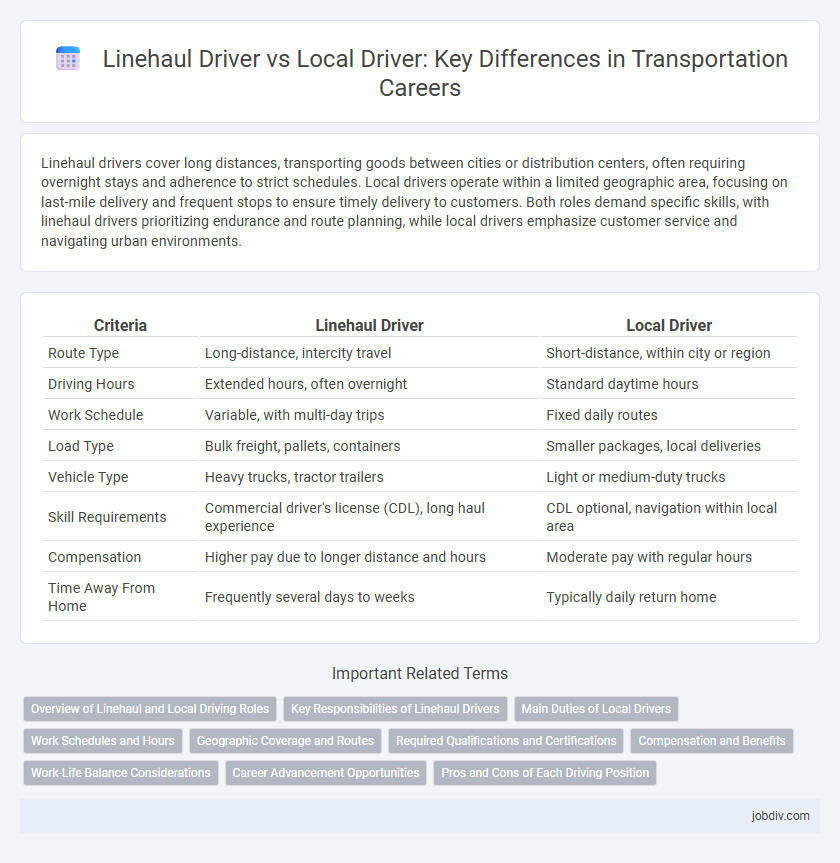Linehaul drivers cover long distances, transporting goods between cities or distribution centers, often requiring overnight stays and adherence to strict schedules. Local drivers operate within a limited geographic area, focusing on last-mile delivery and frequent stops to ensure timely delivery to customers. Both roles demand specific skills, with linehaul drivers prioritizing endurance and route planning, while local drivers emphasize customer service and navigating urban environments.
Table of Comparison
| Criteria | Linehaul Driver | Local Driver |
|---|---|---|
| Route Type | Long-distance, intercity travel | Short-distance, within city or region |
| Driving Hours | Extended hours, often overnight | Standard daytime hours |
| Work Schedule | Variable, with multi-day trips | Fixed daily routes |
| Load Type | Bulk freight, pallets, containers | Smaller packages, local deliveries |
| Vehicle Type | Heavy trucks, tractor trailers | Light or medium-duty trucks |
| Skill Requirements | Commercial driver's license (CDL), long haul experience | CDL optional, navigation within local area |
| Compensation | Higher pay due to longer distance and hours | Moderate pay with regular hours |
| Time Away From Home | Frequently several days to weeks | Typically daily return home |
Overview of Linehaul and Local Driving Roles
Linehaul drivers transport goods over long distances between cities or distribution centers, often requiring extended hours on highways and adherence to strict schedules. Local drivers operate within a confined geographic area, managing last-mile deliveries and customer interactions, prioritizing route efficiency and frequent stops. Both roles demand specialized skills in vehicle handling, compliance with safety regulations, and timely delivery performance.
Key Responsibilities of Linehaul Drivers
Linehaul drivers are responsible for transporting freight over long distances, typically between cities or states, ensuring timely delivery according to specified schedules. They manage route planning, maintain vehicle inspections, and adhere to safety regulations to handle extended driving hours efficiently. Unlike local drivers, linehaul drivers focus on cross-country logistics and often coordinate with multiple terminals or distribution centers.
Main Duties of Local Drivers
Local drivers primarily manage short-distance deliveries within a specific geographic area, ensuring timely pickup and drop-off of goods. Their duties include navigating urban routes, handling loading and unloading, and maintaining consistent communication with dispatch for route adjustments. Unlike linehaul drivers, local drivers often interact directly with customers, providing essential service in last-mile delivery operations.
Work Schedules and Hours
Linehaul drivers typically operate on long-haul routes, often driving 8 to 12 hours per day with irregular schedules that can include overnight shifts and extended periods away from home. Local drivers usually work more consistent daytime hours, around 8 to 10 hours per day, with predictable start and end times, allowing them to return home daily. The work schedule for linehaul drivers involves federal Hours of Service (HOS) regulations to manage fatigue, while local drivers often experience more flexible breaks and shorter driving distances.
Geographic Coverage and Routes
Linehaul drivers cover long distances between cities or regions, often traveling across multiple states or states' borders, enabling intercity or interstate freight transportation. Local drivers operate within a specific metropolitan area or region, focusing on short routes and frequent stops for last-mile delivery or local pickups. Geographic coverage for linehaul drivers demands endurance and navigation through diverse routes, while local drivers prioritize knowledge of neighborhood streets and efficient route optimization.
Required Qualifications and Certifications
Linehaul drivers require a Commercial Driver's License (CDL) with endorsements for long-haul freight and often must meet higher experience thresholds due to extended interstate travel. Local drivers typically need a standard CDL and must demonstrate knowledge of regional routes and delivery procedures. Both roles demand a clean driving record, medical certification under the Department of Transportation (DOT) standards, and adherence to safety regulations.
Compensation and Benefits
Linehaul drivers typically receive higher compensation than local drivers due to longer routes and extended hours, often including per diem allowances and access to comprehensive health benefits. Local drivers usually benefit from more regular schedules, enabling better work-life balance, and may qualify for performance bonuses and company-provided vehicles. Both roles offer retirement plans and paid time off, but linehaul positions often feature higher overtime pay and lodging stipends reflecting their demanding travel requirements.
Work-Life Balance Considerations
Linehaul drivers spend extended hours on the road, often covering long distances between cities, which can lead to irregular schedules and extended time away from home, impacting work-life balance negatively. Local drivers typically have more predictable routes within a confined geographic area, allowing for regular daily home time and greater opportunity to manage personal commitments. Companies aiming to improve driver retention should consider these differences when developing schedules and support programs to enhance overall well-being.
Career Advancement Opportunities
Linehaul drivers often experience faster career advancement due to the larger scale operations and long-haul logistics companies they work for, which offer roles in fleet management and route planning. Local drivers benefit from consistent daily schedules that can lead to supervisory positions within regional distribution centers or last-mile delivery services. Both career paths provide unique opportunities for skill development, but linehaul driving typically opens doors to broader logistics management roles.
Pros and Cons of Each Driving Position
Linehaul drivers excel in long-distance freight transport, offering higher pay rates and consistent interstate routes but face extended periods away from home and increased fatigue risks. Local drivers benefit from predictable daily schedules and frequent home returns, promoting better work-life balance, yet often endure stop-and-go traffic and heavier lifting demands. Choosing between linehaul and local driving depends on prioritizing earning potential versus lifestyle preferences within the transportation industry.
Linehaul Driver vs Local Driver Infographic

 jobdiv.com
jobdiv.com